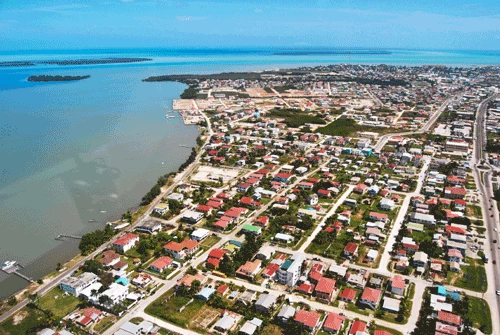If you have ever wondered where paradise on earth could be, think about Belize. Famous island beaches, pristine forests, and ancient Mayan ruins – what else could you ask for? An upper middle income country alongside Panama, the Dominican Republic or Suriname, and with an income per capita of around US$4,800, Belize has certainly done well for a country that gained independence from the British only in 1981. The vibrant economy relies on two growth drivers, tourism and agro-business. Tourism employs 28 percent of the population and represents 21 percent of GDP while agriculture employs 10 percent of the labor force and contributes 13 percent of GDP, mostly through exports of sugar and tropical fruits. The country also hosts the largest living barrier reef in the world and is a paradise for divers and marine wildlife.
But what all this beauty and natural resources actually mean for Belize’s development prospects? How does the country fare compare to its neighbors? Our report Belize: Right Choices, Bright Future highlights the need for a big push to accelerate progress in education, crime and violence, and climate resilience in order put the country back on a path for sustainable growth.
Education quality matters
Only 45 percent of secondary school aged children attend school, substantially lower than the regional average of 80 percent, and one in four children from the bottom 20 percent of the income distribution attend secondary school. Improving education and skills would positively impact growth, innovation, inclusion, and sustainability. Higher learning outcomes, greater equity and access to education would better equip workers for the acquisition of skills demanded by the labor market and position them well to compete for better-paying jobs if they decide to emigrate. The entry points to improve education and skills include: investments to improve the quality of education at all levels of instruction, increasing access to primary and secondary education, improving teacher training, and more tailored vocational training to respond to the needs of the market, including training of migrants.
Preventing crime, a priority to drive growth
Belize homicide rate has increased 150 percent between 2000 and 2010, and was the sixth highest in the world in 2010. Like for its neighbors, preventing crime and violence would have positive spillovers on competitiveness and growth. For this, it would be essential to create income and learning opportunities to steer the youth away from joining criminal organizations, provide them with a safer environment for learning, and ultimately help raising their skills profile and find jobs in the labor market.
Continued efforts to build climate resilience
Belize has made great strides to increase environmental resilience, but the country remains vulnerable to severe weather events. The countryfaces average losses of about 3 percent of GDP due to extreme weather events and with climate change the frequency and intensity of such events are expected to increase. Poor communities are disproportionately vulnerable to bad weather events – particularly in the southern and northern parts of the country. Continued attention to disaster risk management and strengthening climate resilience will help protect the limited assets of poor communities and improve connectivity and the livelihoods of these vulnerable communities.
Small size, yet great opportunities
As a small open economy, Belize relies considerably on international trade. As in other small countries in the Caribbean and Central America, Belize’s small size makes the country vulnerable to terms of trade shocks and volatility. The small size also means that the country has a limited supply of labor and capital and faces the challenge of economies of scale. All small economies face difficulties to generate savings. With limited savings, small economies find it more challenging to finance investments and may be trapped in a low-growth equilibrium. But there is no reason to believe that Belize is cursed by its smallness. Belize can be quite successful and generate greater prosperity and sustainable growth through institutional reforms that would allow the economy to incorporate technological innovation, increase productivity, and diversify products and partners.
Belize has great economic opportunities, but like in many Caribbean countries limited availability to social and economic data prevents the government and prospective investors from making more informed decisions. Greater financial inclusion could help raise savings and investments which would have a positive impact on growth. Last but not least, sustainable progress will also require prioritizing fiscal sustainability.



Join the Conversation